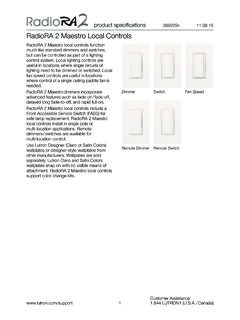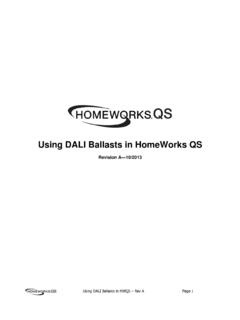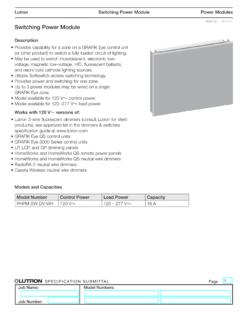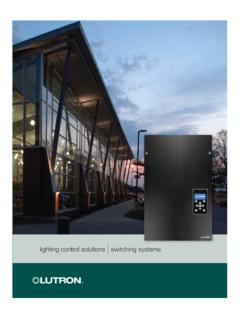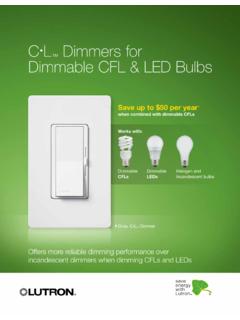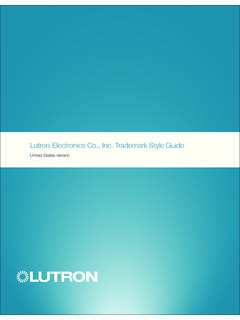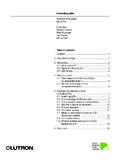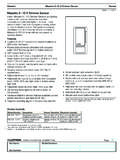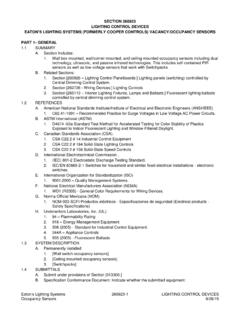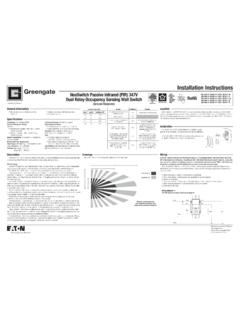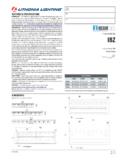Transcription of EcoSystem Design and Application Guide - Lutron …
1 EcoSystem Design and Application GuideLutron | 01 Technical Support: 24 hours/7 days (US/CAN) EcoSystem Energy-saving strategies60% High-end trim/Tuning 1 (20% lighting) Occupancy or vacancy sensing 2 (15% lighting) Daylight harvesting 3 (15% lighting) Personal dimming control 4 (10% lighting)Energi Savr Node with EcoSystem modulepg. 21 Radio Powr Savr wireless daylight sensor pg. 24 NEW Radio Powr Savr wireless occupancy and vacancy sensorpg. 26 NEW Pico wireless controlspg. 28 Potential lighting energy savingsSources can be found on pg. EcoSystem H-Series digital ballastspg. 16 Lutron solutions do more than just control the light in a space. With the right Design strategies, they can save substantial amounts of energy, reduce operating costs, and improve | Lutron Lutron World Headquarters: 0 0 Lutron | 03 Technical Support: 24 hours/7 days (US/CAN)The new EcoSystem H-Series ballast is a cost-effective digital ballast option designed to meet the growing need for intelligent energy savings.
2 The H-Series ballast offers superior capability, easy setup, and increased flexibility, see pg. ! EcoSystem is designed for office spaces, K 12/university classrooms, and patient rooms, where lighting typically accounts for 39% of electricity usage. These applications benefit from EcoSystem s unparalleled energy savings achieved through the use of personal controls including wallstations and infrared remote control transmitters, and environmental sensors such as daylight and occupancy/vacancy sensors. In addition to providing energy savings, EcoSystem creates a more flexible workspace in which lighting fixtures with EcoSystem fluorescent ballasts and LED drivers are individually addressed. These ballasts and drivers are programmed, instead of wired, to work individually or as a group, creating flexibility in a space that adjusts to the shifting needs of any , EcoSystem features fewer parts and user-friendly programming reducing lighting system maintenance.
3 Environmental sensors and personal controls integrate wirelessly or connect directly to any ballast, Energi Savr Node module, or QS sensor module, eliminating interfaces, power packs, and control devices. EcoSystem is a lighting control system comprised of digital fluorescent dimming ballasts, LED drivers, controls, and environmental sensors. Working together, these components: save up to 60% of lighting electricity usage increase space flexibility increase occupant comfort and productivity reduce maintenance costsEcoSystem 1 Energy Information Administration, 2003 Commercial Buildings Energy Consumption Survey, released April 2009. ( ) Annual electricity use in commercial buildings1 LightingOffice EquipmentOther0510152025303540 HVAC18% 15% 60% 39% 28% Save 60% of lighting energySave 10-30% of HVAC energyLutron solutionsEcoSystem Design and Application guide04 Energy-saving light control strategies 06 Codes and standards08 Foundation for a system 10 How to Design a system 12 Wiring overview Components16 EcoSystem H-Series digital ballasts17 Hi-lume 3D digital ballasts18 EcoSystem digital ballasts with integral sensor connections19 EcoSystem digital ballasts20 Hi-lume A-Series LED drivers21 Energi Savr Node with EcoSystem module22 QS sensor module23 Other Energi Savr Node modules24 Daylight sensors26
4 Occupancy/Vacancy sensors 28 Pico wireless controls29 Infrared receivers and remote control transmitters30 s e eTo u c h QS wallstations31 EcoSystem wallstations32 QS interfaces33 Programming 34 Expanding the system 36 Concept drawings 42 Emergency system integration43 System hierarchy44 Buy American Act45 Custom ballast factor04 | LutronLutron | 05 Technical Support: 24 hours/7 days (US/CAN) Lutron World Headquarters: 0 0 Daylight harvestingTake advantage of available daylight. Adjust electric lighting smoothly, unobtrusively and continuously. Best applied in areas with large windows or skylights, such as perimeter offices, classrooms, malls, and lighting energy savings: 15%3 Potential lighting energy savings when combining all light control strategies: 60%+Personal dimming controlProvide personal choice and control of light levels to accommodate for different tasks and activities.
5 Permit dimming from multiple locations. Allow the ability to turn lights on and off. Best applied in areas such as meeting rooms, offices, classrooms, and patient lighting energy savings: 10%4 High-end trim/TuningSet the maximum light level in a space based on customer or Design requirements. Best applied in daylit spaces such as open office areas, classrooms, and corridors or when retrofitting an existing lighting energy savings: 20%1 Occupancy/Vacancy sensingSlowly dim lights to a low level or turn lights off when the space is unoccupied; turn lights on when someone enters. Best applied in enclosed areas such as meeting rooms, offices, classrooms, and lighting energy savings: 15%2 Intelligent lighting control offers a significant energy- saving opportunity Despite the fact that most lighting is energy-efficient fluorescent.
6 The number-one source of energy consumption in any building is still fOf f0%100%7 AMNoon7 PMElectricity UsageOf fOf f7 AMNoon7 PMElectricity UsageSavingsSavingsLights on0%100%Of fOf f7 AMNoon7 PMElectricity UsageSavingsSavingsSavingsLightson0%100% Of fOf f7 AMNoon7 PMElectricity UsageLights onSavingsLights on0%100%Of fOf f0%100%7 AMNoon7 PMElectricity UsageOf fOf f7 AMNoon7 PMElectricity UsageSavingsSavingsLights on0%100%Of fOf f7 AMNoon7 PMElectricity UsageSavingsSavingsSavingsLightson0%100% Of fOf f7 AMNoon7 PMElectricity UsageLights onSavingsLights on0%100%Of fOf f0%100%7 AMNoon7 PMElectricity UsageOf fOf f7 AMNoon7 PMElectricity UsageSavingsSavingsLights on0%100%Of fOf f7 AMNoon7 PMElectricity UsageSavingsSavingsSavingsLightson0%100% Of fOf f7 AMNoon7 PMElectricity UsageLights onSavingsLights on0%100%Of fOf f0%100%7 AMNoon7 PMElectricity UsageOf fOf f7 AMNoon7 PMElectricity UsageSavingsSavingsLights on0%100%Of fOf f7 AMNoon7 PMElectricity UsageSavingsSavingsSavingsLightson0%100% Of fOf f7 AMNoon7 PMElectricity UsageLights onSavingsLights onEnergy-saving light control strategies1 Newsham, G.
7 R.; Donnelly, C.; Mancini, S.; Marchand, ; Lei, W. Charles, ; Veitch, (August 13-18, 2008). The effect of ramps in temperature and electric light level on office occupants: a literature review and laboratory experiment. Institute for Research in Construction. Retrieved from IESNA 2000 Proceedings, Paper #43: An analysis of the energy and cost savings potential of occupancy sensors for commercial lighting systems. Occupancy sensor savings range from 17% to 60% depending upon space type and time delay settings. 3 US Department of Energy. How to Select Lighting Controls for Offices and Public Buildings. Claim: 27% potential savings using daylight IESNA 2000 Proceedings, Paper #34: Occupant Use of Manual Lighting Controls in Private Offices.
8 Giving the occupant manual switching and dimming provided a total of 15% added savings above the 43% achieved by motion sensors. 06 | LutronLutron | 07 Technical Support: 24 hours/7 days (US/CAN) Lutron World Headquarters: 0 0 Codes and standardsASHRAE Energy Code 2010 ASHRAE Energy Code 2010 is the newest energy standard and is the basis for most state-specific codes as well as the IECC code. The following chart outlines sections of the ASHRAE code most applicable to lighting energy, and identifies the Lutron lighting control solutions that can help you meet and exceed these codes. For more specific information on energy codes in your state, visit SectionLighting Control SolutionAutomatic Lighting Shut-off ( )Interior lighting shall be controlled with an automatic control device to shut off building lighting in all spaces (no 5,000 sq.)
9 Ft. minimum building size) EcoSystem with wired or wireless occupancy/vacancy sensors and timeclock integrationSpace Control ( )Multi-level lighting The controlled lighting in a space shall have at least one control step between 30% and 70% (inclusive) of full-lighting power in addition to all off. EcoSystem with dimming control; multi-scene controlEach space enclosed by ceiling height partitions shall have at least one control device to independently control the general lighting within the Savr Node modules with s e eTou c h QS wallstations, EcoSystem wallstations and/or Pico wireless controlsAn occupant sensor or timer switch shall be installed that automatically turns lighting off within 30 minutes of all occupants leaving a space (specific room type are defined within the code).
10 EcoSystem with occupancy/vacancy sensors, integration with a timeclock, or after hours modeASHRAE SectionLighting Control SolutionAutomatic Daylighting Controls for Primary Sidelighted Areas ( ) and for Toplighting ( )Sidelighted areas larger than 250 sq. ft. (and/or daylighted areas under skylights larger than 900 sq. ft.) must have a multi-level photocontrol that reduces electric lighting in response to available daylight with at least one control step that is between 50% and 70% of Design lighting power and another control step that is no greater than 35% (including off) of Design with wired or wireless daylight sensor(s)Additional Lighting Control ( )Stairwell lighting Lighting in enclosed stairwells shall have one or more control devices to automatically reduce lighting power in any one controlled zone by at least 50% within 30 minutes of all occupants leaving that controlled zone.
